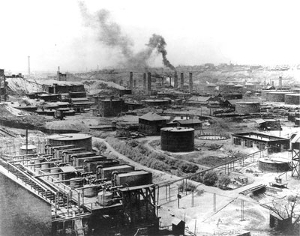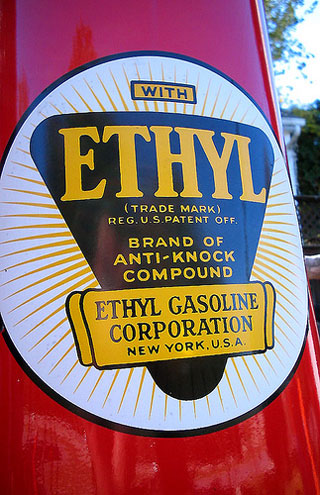|
 The
workers at the Standard Oil Refinery in New Jersey, gave the
building that name, waving goodbye to their colleagues when they
entered the shadowed opening, promising to have undertakers
waiting when they came out. The building was only one year old,
that fall of 1924, but it had earned the nickname. The
workers at the Standard Oil Refinery in New Jersey, gave the
building that name, waving goodbye to their colleagues when they
entered the shadowed opening, promising to have undertakers
waiting when they came out. The building was only one year old,
that fall of 1924, but it had earned the nickname.
It looked harmless enough from the outside, the usual style of
factory buildings on the New Jersey site, the familiar rectangle
of neat red brick with narrow windows set in stone. Inside, the
first impression was also of routine, noise and heat, the hiss
and clank of the pipes, the grumble and clatter of the retorts.
And then the unfamiliar, a smell carried by vapors rising from
the machinery, not the usual odor of gasoline, but the dull
musty scent of tetraethyl lead.
Five years earlier, a chemical engineer working for General
Motors had discovered that tetraethyl lead cured a stubborn
knocking problem in the car engines. Even GM’s best cars, its
elegant Cadillacs, banged so loudly under the hood that
customers worried that the engines were breaking apart. The
noise was a natural byproduct of the engine’s design in which
gasoline tended to mix with air, heat, spontaneously ignite and
explode, sometimes loudly enough to startle a driver into losing
control.
Tetraethyl lead – or TEL as the industrial shorthand referred to
it – solved that problem. As we know now – or, more accurately,
have known for decades now – it caused many more. But what most
people don’t know – and what I didn’t learn until I started
researching the toxicology of the early 20th century – is that
scientists warned of, and tried to prevent, those lead-based
problems back in the 1920s. Their evidence was, in fact, so
solid that that some cities, like New York, attempted to block
its use. They were overruled by a federal government that
preferred to ally itself with major corporations. A cautionary
tale, you might say, although not a lesson we’ve followed with
any notable consistency.
Tetraethyl lead was nothing new back then; it was actually a
19th century discovery from European laboratories. But that
innovative GM engineer, one Thomas Midgley, Jr., put it to a new
use. (Midgley would later become notorious among
environmentalists for his contribution not only to leaded
gasoline but to the worldwide use of chlorofluorocarbons).
Midgley was working under the direction of GM research head
Charles Kettering when he made his key discovery regarding those
knocking engines: tetraethyl lead (a chemical blending of lead,
carbon and hydrogen) bonded with the fuel, enveloping it into a
happily non-explosive material.
Both the automobile and the oil industry took instantly to
Midgley’s anti-knock solution, pouring money into production facilities, advertising its wonders. One of the earliest
factories to make the additive was the Standard Oil facility in
Bayway, New Jersey. And it was there, in the loony gas building,
that the warning signs became obvious.
facilities, advertising its wonders. One of the earliest
factories to make the additive was the Standard Oil facility in
Bayway, New Jersey. And it was there, in the loony gas building,
that the warning signs became obvious.
In the twelve months since the company had begun making the
anti-knock ingredient, plant laborers’ fear of the place had
steadily increased. The men who worked in the TEL building, in
the clanking heat and drifting vapors, had become increasingly
odd – moody, short-tempered, unable to sleep. Some of the
workers started getting lost on the familiar plant grounds, had
trouble even remembering their friends. And then, in October of
1924, laborers from that same building started collapsing, going
into convulsions, babbling deliriously. By the end of September,
32 of the 49 TEL workers were in the hospital and five of them
died.
Standard Oil issued a coolly dismissive response: “These men
probably went insane because they worked too hard,” the building
manager told The New York Times. Those who didn’t survive had
merely worked themselves to death, he continued, due to
enthusiasm for the job.
Other than that, the company didn’t really see a problem at all.
The Standard Oil explanation failed to impress the state of New
Jersey. It ordered the plant closed. The local district attorney
wasn’t impressed either. He called the chief medical examiner
from New York City, Charles Norris, and asked if his innovative
chemistry division could do some research into the compound.
Norris was happy to do so. He hadn’t liked Standard Oil’s
position either. He decided, in fact, to issue his own
statement, contradicting the industry’s perspective on TEL in
explicit terms: “The fact that it is readily absorbed and highly
poisonous was discovered in Germany about 1854 when tetraethyl
lead was discovered, and it has not been used in industry during
most of its seventy years since then because of its known
deadliness.”
Investigators discovered that before the illnesses at Standard
Oil, another TEL processor, the DuPont Company, had lost two
workers at its Dayton, Ohio plant. They had died from lead
poisoning. Lead was well known, as Norris emphasized, for its
tendency to damage the nervous system. And lead-laced vapors,
like those emitted in TEL manufacturing, absorbed through the
skin and were inhaled directly into the lungs.
It turned out, in fact, that months before the New Jersey
workers died, several of the supervisors at the loony gas
building had recommended that the production be shut down.
They’d become alarmed themselves by the way the increasingly
bizarre behavior of the workers and by the signs of obvious
illness.
Standard Oil did not back down. In answer to this new round of
criticisms, the company organized a press conference at its
Manhattan offices (not in New Jersey, of course), featuring the
developer of tetraethyl lead himself. Midgley assured reporters
that handled properly there was nothing dangerous about his
prized discovery. To prove it, he washed his hands in a bowl
filled with TEL. “I’m taking no chances whatever,” he said. “Nor
would I take any chances by doing that every day.”
Like Standard Oil executives, he blamed the workers, both at
Dupont and at the New Jersey plant, for failing to protect
themselves properly. Gloves and masks had been available at the
refinery; it was the workers’ responsibility to wear them. But
they weren’t well educated men, a company vice president
explained to the reporters, and perhaps the employees hadn’t
realized that working with TEL was “man’s work”, with all the
risks implied.
He was right, of course, that the loony gas workers didn’t know
what the risks were. But neither – even at that moment – did he. |